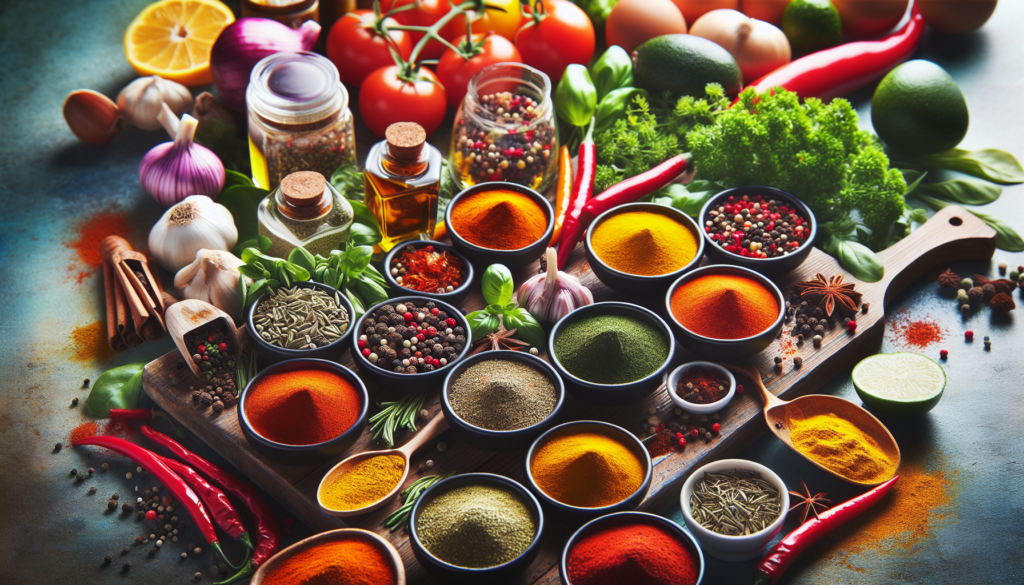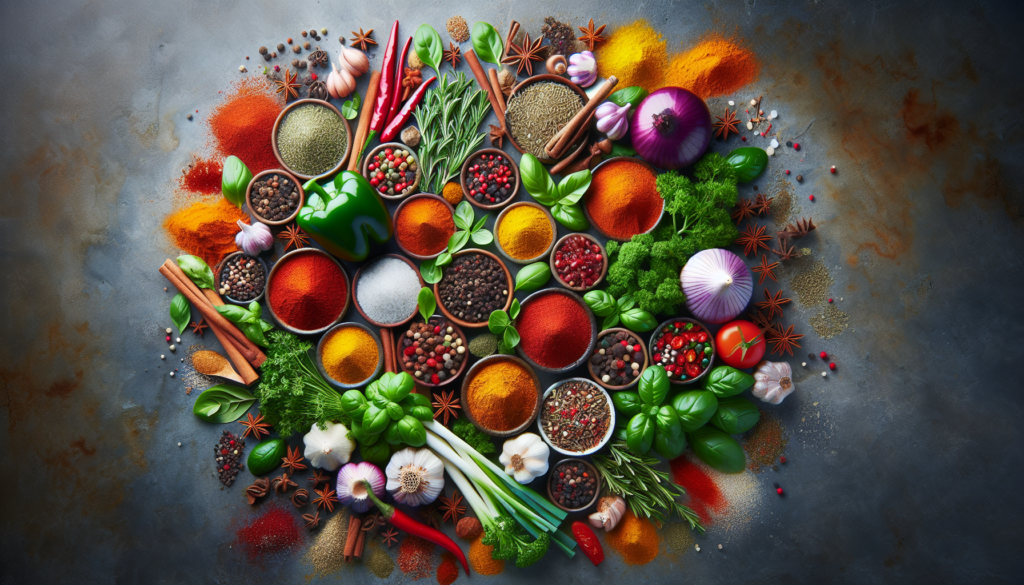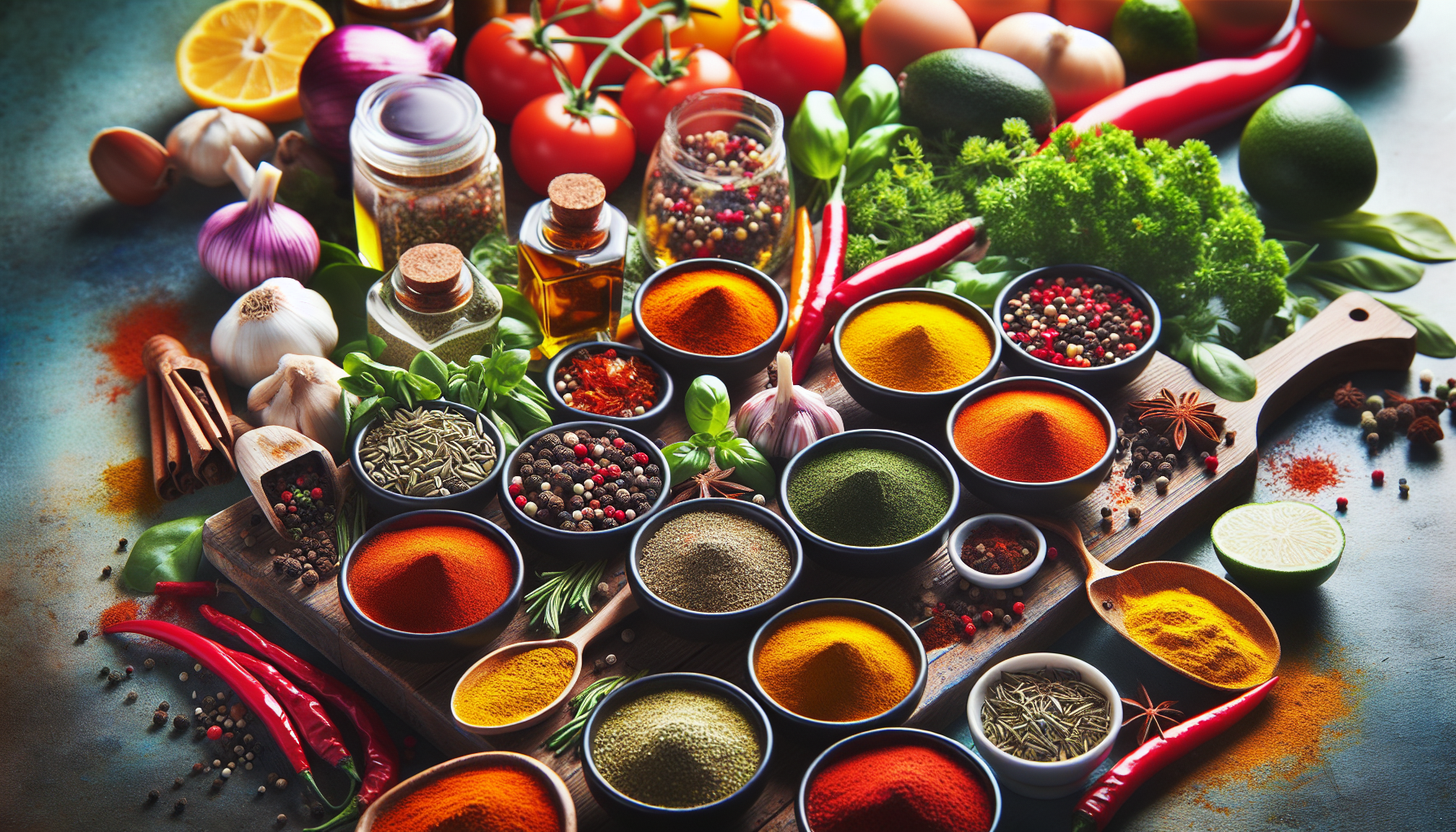Are you tired of bland and uninspiring solo meals? If so, you’re not alone. Many people struggle to find the right balance of flavors when cooking for themselves. But fear not, because in this article, we will explore the world of seasoning tips specifically tailored for solo cooking dishes. Whether you’re a novice in the kitchen or a seasoned veteran, these tips will help you elevate your solo meals to a whole new level of deliciousness. So get ready to embark on a culinary adventure and discover the secrets to creating mouthwatering solo dishes bursting with flavor.

Choosing the Right Seasonings
When it comes to choosing the right seasonings for your dishes, it’s important to start by understanding the flavor profile of the dish you’re preparing. Consider the main ingredients and the desired taste you’re aiming for. Is it a spicy dish? A savory one? Sweet and tangy? By understanding the flavor profile, you can better select the seasonings that will complement and enhance the dish.
Using herbs and spices is a fantastic way to add depth and complexity to your dishes. Herbs like basil, rosemary, and thyme can bring a fresh and earthy flavor, while spices such as cumin, paprika, and turmeric can add warmth and richness. Experiment with different combinations to find the perfect balance that suits your tastes. Don’t be afraid to be creative and try new herbs and spices to discover unique flavor profiles.
Another important factor to consider is the heat level of your seasonings. Some people enjoy spicy dishes, while others prefer milder flavors. It’s crucial to know your own preferences and adjust the heat level accordingly. You can use ingredients like chili powder, cayenne pepper, or hot sauce to add a fiery kick, or opt for milder alternatives such as black pepper or paprika for a subtler heat. Remember to taste as you go and adjust accordingly to achieve the desired level of spiciness.
Mixing and matching flavors is a great way to create a well-rounded and complex taste. Combining sweet and savory flavors can create a delicious contrast, while balancing tangy and bitter elements can add depth. Don’t be afraid to experiment with different flavor combinations to find your own unique style. With a little bit of creativity, you can elevate your dishes and surprise your taste buds with delightful and unexpected flavors.
Enhancing the Taste
To enhance the taste of your dishes, you need to consider balancing the five basic tastes: sweet, sour, salty, bitter, and umami. Each taste plays a different role in creating a well-rounded and flavorful dish. Sweetness can add a pleasant contrast to savory dishes, while sourness can bring brightness and freshness. Salty flavors enhance the overall taste, and bitterness can provide a delightful complexity. Lastly, umami, also known as the “fifth taste,” adds a savory and meaty depth to your dishes.
Umami is often considered the secret weapon of professional chefs. It can be achieved by incorporating ingredients such as mushrooms, soy sauce, fish sauce, or parmesan cheese. Experimenting with umami-rich ingredients can take your dishes to a whole new level, providing a depth of flavor that is sure to impress.
Acidity is another element that can enhance the taste of your dishes. Adding acidic ingredients like lemon juice, vinegar, or even a splash of wine can brighten and balance the overall flavor. Acidic ingredients can cut through richness and add a tangy note that complements various dishes, from salads to marinades. Just remember to use acidity sparingly as too much can overwhelm the other flavors.
Sweetness, when used wisely, can also help enhance the taste of a dish. It can balance out spiciness or counteract bitterness. However, be careful not to overdo it, as an overly sweet dish can quickly become cloying. Use sweetness sparingly and aim for a subtle touch that complements the overall flavor profile.
Building Layers of Flavor
Building layers of flavor is a key technique to take your dishes from ordinary to extraordinary. Dry rubs and marinades are excellent methods to infuse flavors into ingredients, especially meats. They allow the seasonings to penetrate deep into the food, resulting in a more flavorful end result. Experiment with different combinations of herbs, spices, and aromatics to create your own signature marinades and dry rubs.
Infusing oils and butters is another fantastic way to add flavor to your dishes. By infusing oils with herbs, spices, or even garlic, you can create a flavorful base that can be used in various cooking methods. Infused butters can elevate the taste of simple dishes like steaks or roasted vegetables. They add richness and complexity, making each bite a delightful experience.
Creating aromatics is an essential step in many recipes. Aromatics like onions, garlic, ginger, and shallots add depth and flavor to your dishes. Sautéing these ingredients in oil or butter before adding other ingredients enhances their taste and creates a flavorful foundation. Incorporating aromatics early in the cooking process allows their flavors to develop and meld with other ingredients, resulting in a more satisfying dish.
Condiments and sauces are also excellent tools for adding layers of flavor. Whether you’re using a classic condiment like ketchup or mustard, or preparing a homemade sauce like hollandaise or barbecue sauce, these additions can take your dishes to the next level. They provide a finishing touch that ties all the flavors together and adds a delicious sauce that complements the main ingredients.
Adapting to Portion Sizes
When cooking solo, it’s essential to adapt the portion sizes accordingly. Scaling down recipes can be a challenge, as many recipes are designed to serve multiple people. One way to overcome this is by using online scaling calculators or simply adjusting ingredient quantities manually. It’s important to maintain the proper ratio of seasonings to ensure the optimal taste experience.
Adjusting spices and flavors is crucial when adapting portion sizes. Too much or too little of a particular seasoning can make or break a dish. Reduce or increase the amount of herbs and spices according to the serving size to maintain the desired flavor profile. Remember to taste and adjust as you go to ensure that the dish is properly seasoned.
Avoiding overwhelming seasoning is crucial when cooking for yourself. It’s easy to get carried away and add excessive salt or spice, especially when adjusting a recipe. To avoid overwhelming your taste buds, start with less seasoning and gradually adjust to your desired taste. Remember, it’s always easier to add more seasoning than to remove it.

Considerations for Solo Cooking
When cooking for yourself, you have the freedom to cater to your personal preferences and dietary restrictions. Experiment with different flavors and get creative with your seasonings. This is your opportunity to tailor your dishes exactly to your liking. Don’t be afraid to try new combinations or spices that you’ve never used before. You may discover new favorites along the way.
Balance convenience and flavor when cooking solo. While it’s tempting to opt for pre-packaged seasonings and sauces, taking the time to prepare your own can yield far superior results. Homemade seasonings and sauces allow you to control the ingredients and tailor the flavors to your liking. This extra effort can make a significant difference in the overall taste of your dishes.
Utilizing Fresh Ingredients
Using fresh herbs and spices can elevate the taste of your dishes. Fresh herbs provide a vibrant and aromatic flavor that dried herbs simply cannot match. Opt for fresh basil, cilantro, parsley, or any other herb that complements your dish. When it comes to spices, consider grinding whole spices whenever possible to maximize their flavor potential.
Choosing seasonal produce is another way to maximize the flavor of your dishes. Seasonal fruits and vegetables are often at their peak in terms of flavor and freshness. They add natural sweetness, tanginess, or earthiness to your dishes. Visit local markets to find the best seasonal produce and take advantage of the abundance of flavors that each season offers.
Maximizing flavor with quality ingredients is essential. While it may be tempting to opt for cheaper options, investing in high-quality ingredients can make a noticeable difference in the taste of your dishes. Quality ingredients, whether it’s a premium olive oil or a freshly-ground spice, can elevate your dishes from good to exceptional. Take the time to source the best ingredients available to you and enjoy the flavorful results.
Exploring Cultural Seasonings
Different regions around the world have their own unique seasoning profiles that reflect their culinary traditions. Exploring these cultural seasonings can be an exciting way to expand your flavor horizons. Whether it’s the bold spices of Indian cuisine, the aromatic herbs of Mediterranean dishes, or the complex flavors of Asian cooking, each culture offers a diverse palette of seasoning options.
Researching global flavor combinations is a great way to learn about the different seasonings used in various cuisines. Delve into cookbooks, food blogs, or online resources to discover new flavor combinations. Pay attention to the herbs, spices, and condiments that are commonly used in different regions. This knowledge can inspire you to experiment with different seasonings and unlock a world of culinary possibilities.
Fusion cooking with different seasonings can lead to exciting and unexpected flavor combinations. Mixing and matching seasonings from different cultures can create a unique and delightful dining experience. Play around with combining spices from different cuisines to create your own fusion dishes. Embrace the creativity and let your taste buds be your guide.
Considering Cooking Methods
Different cooking methods can greatly impact the way seasonings interact with the food. Grilling and seasoning, for instance, can create a delicious smoky flavor that complements various meats and vegetables. Pan-frying with spices can result in a crispy and flavorful crust. Baking with seasonings can infuse the entire dish with aromatic notes. Slow cooking with herbs can create tender and fragrant dishes. Understanding the relationship between cooking methods and seasonings allows you to make the most of each technique and create dishes with incredible flavor.
Using Salt Effectively
Salt is a fundamental seasoning that can make or break a dish. Understanding the different types of salt is essential. Fine table salt is commonly used for general seasoning, while coarse sea salt is often used as a finishing touch. Kosher salt is ideal for seasoning meats due to its texture and flavor. Each type of salt has its own unique qualities, so consider experimenting to find your preferred type.
Seasoning throughout the cooking process is key to achieving a well-balanced taste. Adding salt at different stages allows the flavors to develop and meld together. Start by seasoning your ingredients at the beginning of the cooking process, and adjust as necessary throughout. Taste as you go and gradually build up the seasoning to avoid oversalting or undersalting.
Avoiding oversalting is crucial for a balanced and enjoyable dish. While salt enhances flavors, it’s easy to go overboard and overpower the other seasonings. Start with a smaller amount of salt and gradually add more if needed. Remember that you can always add more salt, but you can’t take it away once it’s been added.
Experimenting with Unconventional Seasonings
Do you ever find yourself curious about the uncommon herbs and spices sitting on the grocery store shelves? This is your chance to get creative and start experimenting with those flavorful ingredients. From exotic spices like sumac or za’atar to rare herbs like epazote or shiso, the world of unconventional seasonings is vast and waiting to be explored. Incorporating these ingredients into your dishes can bring a whole new dimension of flavor that will impress your taste buds.
Incorporate ethnically diverse ingredients into your seasoning repertoire. Different cultures often use ingredients that may be unfamiliar to you, but can add a special touch to your dishes. Whether it’s using tamarind paste in Indian cuisine, fish sauce in Thai dishes, or gochujang in Korean cooking, exploring these ingredients can expand your culinary horizons and introduce you to incredible new flavors.
Don’t be afraid to try unusual combinations of seasonings. Mixing unexpected flavors can result in surprisingly delicious results. Some unconventional combinations might include using cinnamon or cocoa powder in savory dishes, or adding a pinch of saffron to your morning scrambled eggs. Let your imagination run wild and experiment with different seasonings to create unique flavor profiles that are sure to excite your taste buds.
In conclusion, choosing the right seasonings is crucial for creating flavorful and satisfying dishes. By understanding the flavor profile of the dish, using herbs and spices wisely, considering heat levels, and mixing and matching flavors, you can elevate your culinary creations to new heights. Enhancing the taste through balancing the five basic tastes, adding depth with umami, experimenting with acidic ingredients, and using sweetness wisely further enriches your dishes. Building layers of flavor through techniques like dry rubs and marinades, infusing oils and butters, creating aromatics, and using condiments and sauces adds complexity and depth. Adapting to portion sizes, considering solo cooking needs, utilizing fresh ingredients, exploring cultural seasonings, considering cooking methods, using salt effectively, and experimenting with unconventional seasonings all play a role in elevating the taste of your dishes. So, don’t be afraid to get creative and try new seasonings as you embark on your culinary adventures. The world of flavors awaits!
